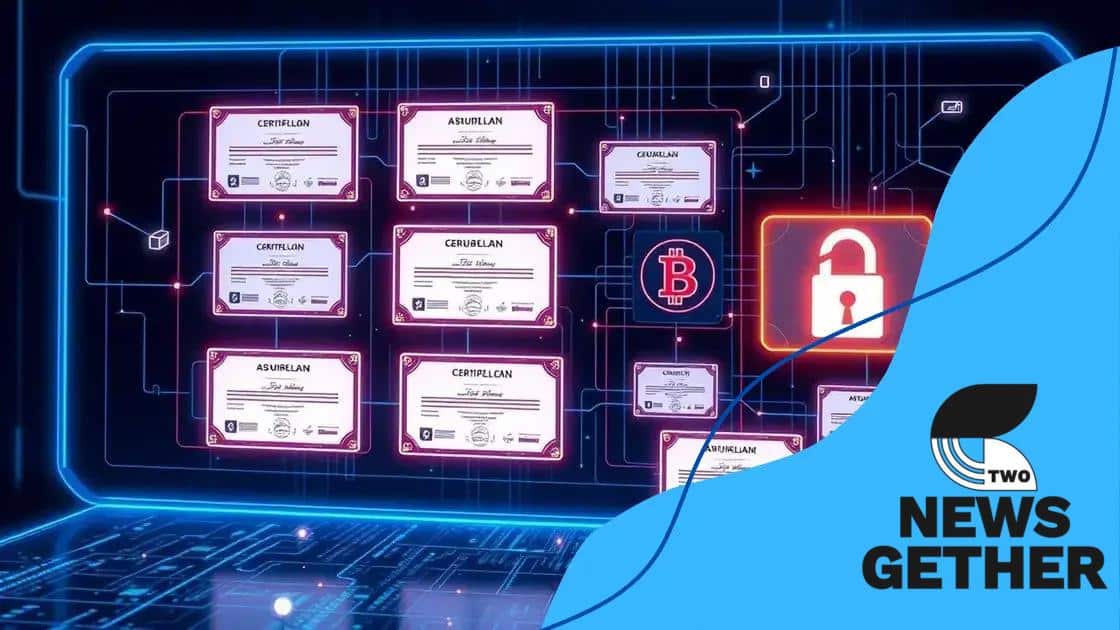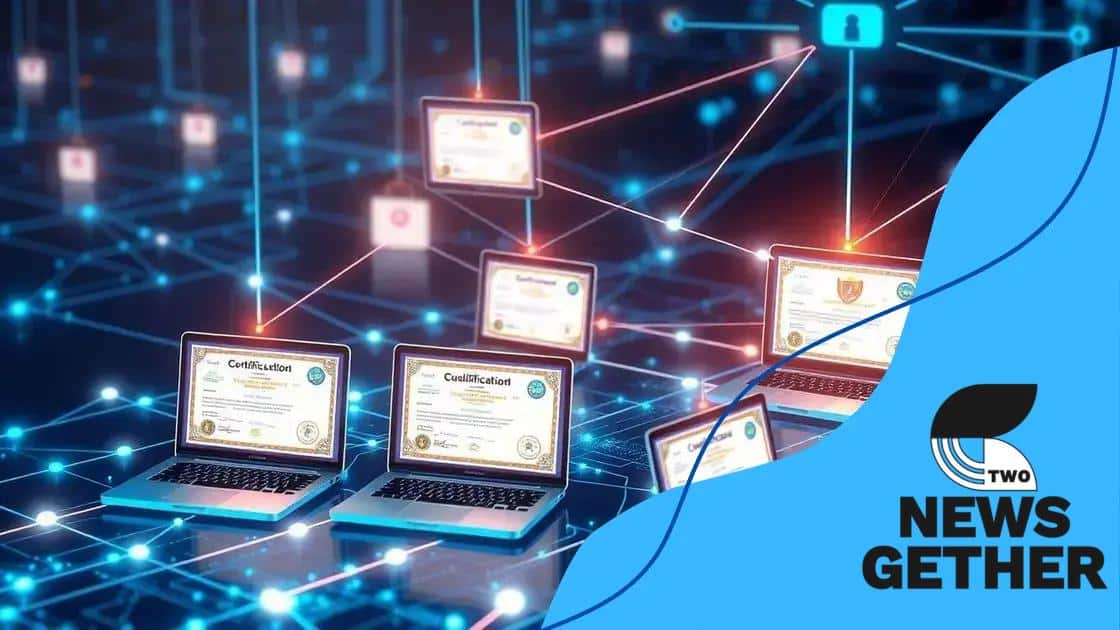The role of blockchain in verifying academic credentials

The role of blockchain in verifying academic credentials enhances security and trust in educational records, providing a transparent, tamper-proof, and efficient verification process for students and employers.
The role of blockchain in verifying academic credentials is becoming increasingly vital in today’s educational landscape. Imagine a world where employers trust the credentials of job applicants without doubt. This could be our reality as blockchain technology reshapes how we verify academic achievements.
Understanding blockchain technology
Understanding blockchain technology is essential to see how it impacts various sectors, including education. At its core, blockchain is a decentralized digital ledger
that records transactions across many computers securely and immutably. This means no single entity can alter the records, which fosters trust and transparency.
Key Features of Blockchain
One of the most notable features of blockchain is its decentralization. Unlike traditional systems, where data resides in a central server, blockchain distributes data across a network. This minimizes the risk of fraud and data loss. Furthermore, the integrity of information is ensured through cryptographic hashes, which make any tampering evident.
Advantages in Education
In academic environments, using blockchain brings numerous advantages. For example:
- Enhanced Security: Academic records stored on a blockchain are safe from unauthorized access.
- Verification Made Easy: Employers can quickly verify the credentials of potential hires.
- Cost Efficiency: Reducing the need for third-party verification saves institutions money.
Moreover, blockchain technology allows institutions to issue certificates that are easily verifiable by anyone. This eliminates the confusion often faced by employers trying to validate degrees and diplomas.
As more educational institutions adopt blockchain, the potential for a more trustworthy framework increases. The innovation not only benefits students and employers but also enhances the overall integrity of academic systems. Understanding blockchain technology is the first step toward embracing its benefits in verifying academic credentials.
Benefits of blockchain in academic verification
The benefits of blockchain in academic verification are numerous and impactful. As schools and employers seek more trustworthy means of confirming educational credentials, blockchain offers an innovative solution.
The first major benefit is enhanced security. Traditional methods of storing and verifying academic records can be susceptible to tampering and fraud. Blockchain’s secure and immutable design protects against unauthorized changes, ensuring that records remain accurate and reliable.
Trust and Transparency
Another significant advantage is the transparency it brings to the verification process. With blockchain, all transactions are recorded publicly, making it easier for employers to verify an individual’s credentials without relying on third parties.
This transparency fosters trust between educational institutions, employers, and students alike. Institutions can issue diplomas and certificates directly onto the blockchain, allowing students to share their qualifications instantly with potential employers. This speeds up the hiring process and reduces delays associated with traditional verification methods.
Cost Efficiency
Cost is another crucial factor. By minimizing the reliance on intermediaries for verification, educational institutions can save a significant amount of money. This ability to streamline the verification process can lead to lower tuition costs for students as institutions find ways to cut back on operational expenses.
- Speed: Verification processes can take days or weeks. Blockchain significantly cuts this time.
- Accessibility: Anyone can access verified records quickly and easily, simplifying the job application process.
- Reduced Errors: With fewer manual processes involved, the likelihood of human error decreases dramatically.
As blockchain technology continues to evolve, its role in academic verification is likely to expand further. The combination of security, transparency, and cost efficiency positions blockchain as a powerful tool for the future of education.
How blockchain increases trust in credentials

How blockchain increases trust in credentials is a crucial aspect of its application in education. Trust in academic qualifications is essential for employers and institutions alike. Blockchain technology enhances this trust in several meaningful ways.
One of the primary ways is through its immutable ledger. Once data is recorded on the blockchain, it cannot be altered or deleted without leaving a trace. This feature provides a permanent record of credentials that is resistant to forgery and tampering. Employers can verify the authenticity of a candidate’s diploma or certificate easily, knowing that the information has not been changed.
Transparency and Accessibility
With blockchain, every transaction is recorded in a transparent manner. This means that anyone with access to the blockchain can review the history of a credential. Such transparency fosters a sense of security, as both employers and students can trust that the information is factual. Verification of credentials becomes a straightforward process, requiring just a click to check the details on the blockchain.
Decentralized Verification
Another important benefit is the decentralization of the verification process. Instead of relying on a single institution or authority to validate credentials, multiple nodes in the blockchain network can provide verification. This distributed nature reduces the chances of biased or inaccurate information while ensuring that multiple parties can confirm the legitimacy of academic records.
- Reduced Fraud: The blockchain’s design makes it exceedingly difficult to create fake documents.
- Real-Time Updates: Academic institutions can update credentials on the blockchain in real-time, ensuring that the latest information is always available.
- Broader Access: Individuals can share their credentials easily with potential employers or institutions across the globe.
By implementing blockchain technology, educational institutions enhance the trustworthiness of their credentials. This change is monumental as it paves the way for a more reliable academic environment, where qualifications are not just pieces of paper but validated assets that can carry weight in the job market.
Challenges of implementing blockchain in education
The challenges of implementing blockchain in education are important to consider as institutions look to innovate. While blockchain has many benefits, some barriers can make adoption difficult.
One major challenge is the initial cost of implementation. Setting up a blockchain system requires investment in technology and training staff. Many educational institutions operate on tight budgets, which can make it hard to justify these expenses. Additionally, transitioning from traditional systems to blockchain can be complex and require extended planning.
Regulatory Concerns
Regulatory issues also pose significant challenges. Each educational institution must ensure that their blockchain implementation complies with existing laws regarding data privacy and security. This can vary significantly by region, adding another layer of complexity. The export and sharing of data across borders may also raise compliance issues.
Resistance to Change
Furthermore, resistance to change among staff and stakeholders can hinder the adoption of blockchain technology. Many educators and administrators may be unfamiliar with the technology, which could make them hesitant to support its implementation. This challenge can slow down the process of adoption, even if the potential benefits are clear.
Technical challenges also exist, as blockchain technology can sometimes be complicated, especially for those who lack technical knowledge. Staff may require extensive training to effectively utilize the new systems. Moreover, ensuring that all stakeholders are on board is essential for successful implementation.
- Integration Issues: Integrating blockchain with existing systems can be difficult and time-consuming.
- Scalability: Some blockchain solutions struggle to scale effectively, especially in large institutions.
- Standardization: A lack of industry standards can lead to varied implementations, making it harder to achieve widespread use.
Despite these challenges, many believe that the potential of blockchain in education outweighs the difficulties. By addressing these obstacles thoughtfully, institutions can better position themselves to leverage this transformative technology.
Future perspectives on blockchain in academia
Future perspectives on blockchain in academia are quite promising. As technology continues to evolve, so do the potential applications of blockchain within educational institutions. The landscape of higher education may soon witness transformative changes driven by blockchain.
One of the most significant prospects is the widespread adoption of digital diplomas. More universities are exploring ways to issue diplomas and certifications via blockchain. This shift allows for verifiable and tamper-proof credentials that are easily accessible for students and employers alike.
Collaboration Across Institutions
Another exciting perspective is the potential for greater collaboration between institutions. Blockchain can allow universities to share and verify credentials across various systems seamlessly. This could foster a more unified approach to education, where students can transfer credits and qualifications more easily than before.
Enhanced Learning Opportunities
Additionally, blockchain technology may facilitate personalized learning experiences. With detailed tracking of student progress on a blockchain, educators could tailor their teaching methods and resources to meet individual student needs. This adaptability may lead to better learning outcomes and more engaged students.
- Research Collaboration: Blockchain could unify research data, making it easier to share findings while ensuring data integrity.
- Funding and Scholarships: Smart contracts on the blockchain may streamline funding processes for scholarships and grants, making them more efficient.
- Coding and Technology Education: As blockchain gains traction, educational programs focusing on coding and blockchain technology will likely become vital for future job markets.
Overall, these future perspectives emphasize a shift toward a more interconnected and secure academic environment. As adoption grows, institutions will need to develop strategies to harness the full potential of blockchain, ensuring that they stay ahead in this competitive educational landscape.
In conclusion, the role of blockchain in verifying academic credentials is becoming increasingly significant. This technology offers a secure and transparent method for educational institutions to confirm qualifications. Although there are challenges to implementing blockchain in education, the potential benefits, such as trust, efficiency, and accessibility, far outweigh these obstacles. As we look to the future, blockchain could lead to innovative changes in how academic records are managed, making the verification process smoother and more reliable for students and employers alike.
FAQ – Frequently Asked Questions about Blockchain in Academia
What is blockchain technology?
Blockchain is a decentralized digital ledger that securely records transactions across a network of computers, making it nearly impossible to alter or fake information.
How does blockchain enhance credential verification?
Blockchain provides a secure and transparent way to verify academic credentials, ensuring that they are tamper-proof and easily accessible to employers.
What are some challenges of implementing blockchain in education?
Challenges include initial costs, regulatory compliance, potential resistance to change, and the need for technical training for staff.
What are the future prospects of blockchain in academia?
Future prospects include issuing digital diplomas, enhanced cooperation between institutions, and personalized learning experiences based on tracked student progress.






